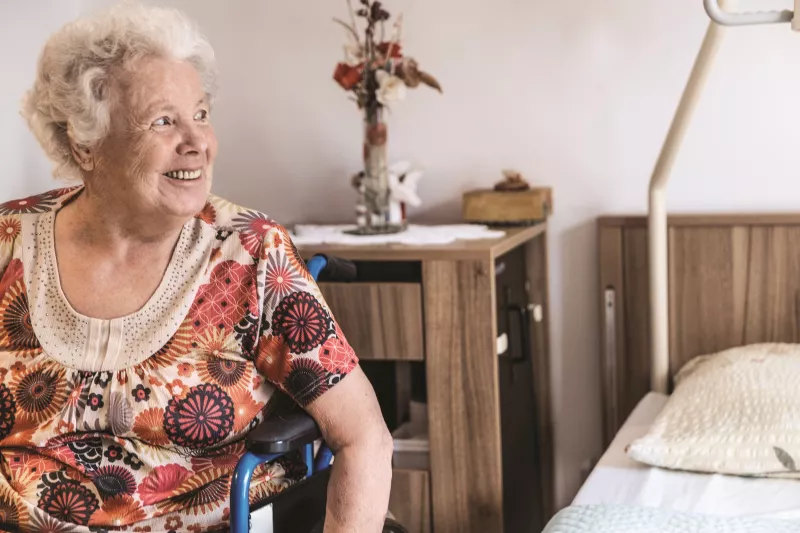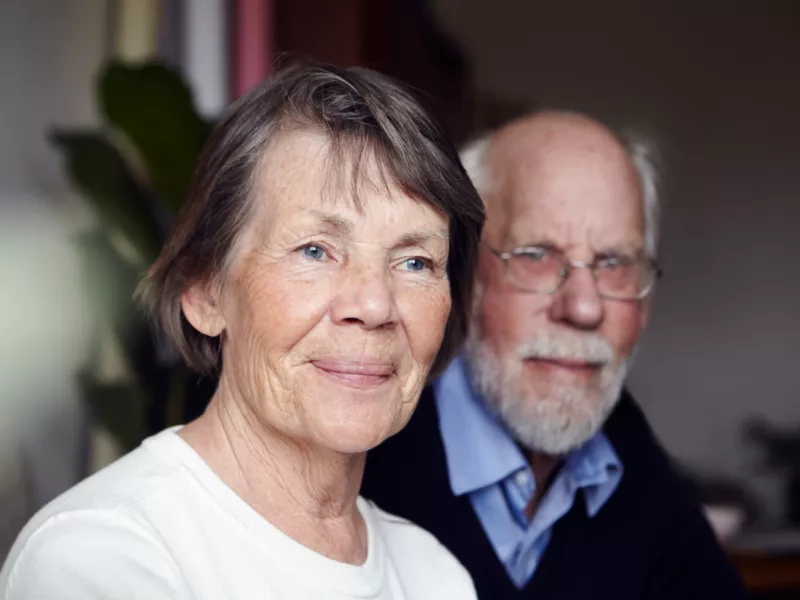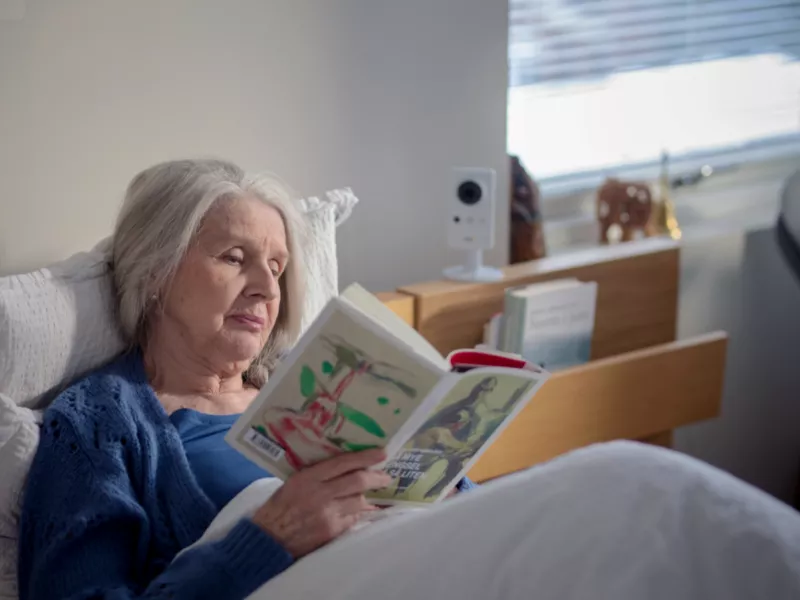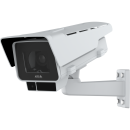
Increased security and better quality of life for care recipients through technology
Better care provision and enhanced quality of life for the elderly and infirm in Grimstad municipality, thanks to a digital solution from Axis and Tellu.
Mission
Instead of moving the elderly and infirm directly to a senior living or managed care facility, Grimstad municipality in southern Norway wanted to find a way to provide quality home health care and extend the independent living possibilities of its residents as long as possible. They should feel safe and get help when they needed it. Grimstad municipality also wanted to ensure that care would be provided to those most in need of it, in order to make optimal use of the "healing hands" of the human resources.
The municipality wanted to increase the security and well-being of residents in senior living facilities. Grimstad municipality also wanted to improve the work environment for the staff and to streamline the workload, both for staff working to help care recipients at home and for staff working at senior living and managed care facilities.
Solution
The municipality ordered the installation of a solution consisting of AXIS P3245-LV and M1065 network cameras, as well as the Digital supervision service from Tellu at the homes of the care recipients. The next step was to install the same solution in senior living and managed care facilities.
Digital supervision via cameras is carried out by healthcare personnel or by staff at a regional or national emergency call centre, often in combination.
Result
Using the solution from Tellu and Axis, people in need of care and healthcare can stay at home longer. What's more, people who previously lived in assisted living facilities have been able to move back home thanks to the solution. Care recipients have a better quality of life, a better night's sleep, and an increased sense of security. It has also meant an increased feeling of security for family and relatives.
The solution has led to major cost savings since healthcare personnel do not need to visit a care recipient unnecessarily, as well as to a smaller carbon footprint thanks to fewer unnecessary trips. For the healthcare personnel, it has also meant freed-up time through correct resource allocation; and they have a calmer work environment with less stress.
We are extremely satisfied with this security enhancing technology. Some patient groups, such as those with dementia, can stay at home for longer. It delays going up a step on the care staircase. This creates a sense of being in control, for them to be able to live in their own home, increasing a sense of security for relatives as well as ensuring patient safety. The technical solutions give us a unique opportunity to adapt to the needs of each patient, where the focus is on the patient.
The elderly can stay home longer thanks to digital solution
For the elderly and infirm, the nights can be cause for concern with the risk of falling and other types of accidents and incidents. Some have sleep problems and get up for a walk at night. A bad night's sleep affects their attention, appetite, and well-being the next day.
Grimstad municipality, located on the south coast of Norway, wanted to ensure that municipality residents could receive supervision and care when they needed it. The goal was that even people with a great need of healthcare and care could also stay at home for as long as possible, and, at the same time, be safe both during the day and at night, but without being disturbed unnecessarily.
It was primarily a question of patients who are older, have a disability, suffer from dementia and cannot tell day from night, are prone to falling, or generally feel insecure and are dependent on home care services and healthcare.
"Grimstad municipality has made a comprehensive investment in healthcare technology, and wanted to develop it further" says Atle Werner Arntsen, welfare technologist at Grimstad municipality.
Care recipients previously had an alarm solution with sensors but without a camera. There was then the possibility that staff would react to events and visit care recipients unnecessarily, even though they were not in any need of healthcare. One example is when sensors triggered an alarm if a patient got out of bed, but on arrival staff found that the patient was back in bed and sleeping soundly. Grimstad wanted to reduce this type of false alarm. In addition, it was a difficult work situation for the healthcare personnel who worked in the geographically vast municipality, and Grimstad wanted to improve the work environment for the healthcare personnel.

Only initial scepticism
Grimstad municipality needed a reliable and secure solution, which would be dependable and easy to manage for the healthcare personnel. The municipality faced three main challenges. The first was the concern of some patients who considered video cameras to be an invasion of privacy. The second challenge was that health personnel were concerned that a technical solution would be used to monitor patients.
Initially, many employees and patients were sceptical, because they felt that a camera solution would risk intruding on personal privacy. It was important to demonstrate that there was no one sitting and monitoring the patients all day long, but only checking the images when a sensor activated an alarm, or at a certain time. Once they had seen all of the benefits, such as that people could stay at home longer and have a better quality of life, everyone became positive.
"If you compare it to the risk of having a stranger barging straight into your flat in the middle of the night – which is the greatest invasion of privacy?" Asks Tanja Fredensborg, a nurse at Grimstad municipality, rhetorically.
A third challenge was that employees and patients initially felt insecure when operating the technology.
Prior to installation, Grimstad municipality organised extensive training and information sessions to demonstrate to staff and care recipients how the solution worked. The municipality developed thorough procedures for using the cameras – in order to ensure safe and reliable use that would respect and safeguard personal privacy.
"When the staff understood how the solution would be used, they thought, "that's not so dangerous"", said Atle Werner Arntsen.
Reliable intelligent overall solution
First of all, the consent of the patients was sought. After that, an integrated solution was installed at the homes of those in need of healthcare, consisting of AXIS P3245-LV and M1065 network cameras, with AXIS Fence Guard and AXIS Video Motion Detection, as well as the Digital supervision service from Tellu, supplier of digital products and solutions in welfare technology. The monitoring of the camera images is performed locally by healthcare personnel, by an operator at a regional or national emergency call centre, or a combination of the two.
The easy-to-use solution allows the staff to remotely see whether patients need some kind of help. In addition, an alarm is triggered by events that activate a sensor. The alarm is sent to a mobile phone, PC or tablet, and healthcare personnel can verify the situation, check what has happened, as well as whether and what measures are required, and continuous surveillance is made possible. The images are transmitted in real time but are not recorded, and the network traffic is encrypted.
Among the benefits of the products, Grimstad municipality highlights their high quality, reliability and stability. Caroline Cappelen, Product Manager at Tellu, adds: "The products are flexible, allow adjustments to be made, are based on open platforms, and include the option to add your own functions. We appreciate the wide range of different types of cameras from Axis."
Long-term and responsive cooperation
Trust is one of the key components of the close cooperation.
"This is a classic example of very good cooperation between our municipality, Tellu and Axis. Tellu's staff are very accessible, competent and responsive, and we've really appreciated the frequent dialogue and unique contact", says Atle Werner Arntsen. "We've been able to call at three in the morning to get help". "It's been an incredibly exciting and successful cooperation, in which we've combined an innovative solution with good functionality", says Caroline Cappelen.

Senior living and long-term care facilities
The next step was to introduce the solution into nursing homes and residential care facilities. Healthcare personnel can easily monitor patients in several different rooms at the same time. The cameras provide very good image quality, and can reproduce sharp images in the dark at night. This means that healthcare personnel do not need to enter the rooms to check whether patients are feeling well or need help; no one wants to wake up the patients unnecessarily.
Elderly care residents often suffer from "the corridor problem," says Caroline Cappelen. This is when they leave their room in the middle of the night, and when they return they take a wrong turn into another resident’s room and wake them up.
Security enhancing technology
The investment in Grimstad municipality has been a great success; the municipality can provide better care for those who need it. Since patients can stay at home for longer, Grimstad municipality has made gains in socio-economic terms, with reduced costs from fewer residents in nursing homes and old people's homes. It has also resulted in welfare gains for individuals who can stay at home, with increased well-being and much better quality of life. Many care recipients get a better night's sleep because they are not disturbed unnecessarily.
"We are extremely satisfied with this security enhancing technology. Some patient groups, such as those with dementia, can stay at home for longer. It delays going up a step on the care staircase. This creates a sense of being in control, for them to be able to live in their own home, increasing a sense of security for relatives as well as ensuring patient safety. The technical solutions give us a unique opportunity to adapt to the needs of each patient, where the focus is on the patient", says Tanja Fredensborg.
Better care
Grimstad municipality has seen a drastic decline in the number of false alarms with fewer emergency call-outs, and can provide better care by means of correct resource allocation.
"There is less pressure on home care services. Using the cameras makes it possible to see if something has happened that needs to be acted on; whether it's a person or a glass of water that's fallen over, or whether they've just gone to the toilet", says Tanja Fredensborg. Some people get a sense of security from knowing that someone is looking after them throughout the night.
Images from the cameras also provide better decision data for the municipality prior to healthcare personnel meeting patients, which means that necessary measures are taken more quickly.
The solution has also resulted in major environmental benefits since staff avoid visiting patients unnecessarily, using the cameras for remote supervision instead. There has been a significant fall in the number of car journeys.
"Our municipality is large and expansive, and at night we just need one car to cover the whole area. This solution is incredibly time and cost saving", says Tanja Fredensborg.
At the care facilities where the solution has been introduced, the staff have increased flexibility and a better working situation with reduced stress, and the ability to better plan their time. Grimstad municipality plans to roll out the solution to additional care facilities.
"In the slightly longer term, we are thinking about even more cameras and an even more developed solution. By then the next generation will have started to advanced in age, and they will have an even greater acceptance of the use of technology", says Tanja Fredensborg.
About the solution from Tellu and Axis
AXIS P3245-LV network camera
- Offers HDTV 1080p in all types of light conditions
- Lightfinder 2.0, which includes increased light sensitivity to capture video images even in darkness
- Forensic Wide Dynamic Range, this means that the camera can reproduce sharp images even with widely varying light conditions in a single image
- Optimised IR, to reproduce clear images in total darkness
- Equipped with Axis ZipStream technology, to reduce the need for bandwidth and storage space
- Large capacity for analysis functions
- Easy to install and handle
AXIS M1065-L network camera
- Offers HDTV 1080p with Power over Ethernet and edge storage
- Built-in microphone and loudspeaker
- Motion sensor
- Bracket for walls and corners
- Wide Dynamic Range, to make it possible to see details even with varying light conditions in a single image
- IR lighting, to facilitate video recording even in darkness
AXIS Fence guard
- Application for intrusion detection
- Virtual indoor and outdoor application
- Multiple profiles for additional flexibility
- Configuration of perspective to reduce false alarms
- Alarm for recording within demarcated areas
- Quick and easy configuration
AXIS Video Motion Detection
- Video analysis application included in most of Axis network cameras and encoders
- Sends warnings when it detects motion from moving objects within predefined areas, such as people and vehicles
- Reduces the need for storage and bandwidth because cameras only record on movement
- Multiple "include" areas
- Filtering of false alarms
- Works in changing lighting conditions
- Quick and easy configuration
Tellu's Digital supervision
- HD camera with IR light for dark rooms
- Microphone for listening and sound notification
- Motion sensor with push-notification, which can be fitted, for example, to a patient’s bed at night and connected to a camera so that when the sensor is activated, an alarm is sent via SMS or e-mail to healthcare personnel and/or a response centre
- Application for computer, mobile and tablet
- Secure login with ID port
- Encrypted video transfer
- Option to anonymise images
- Connected e-health platform
Products & solutions

Healthcare
Our partner organizations
Get in touch
Want to know how you can benefit from Axis solutions? Get in touch and we will help you.
Contact us
